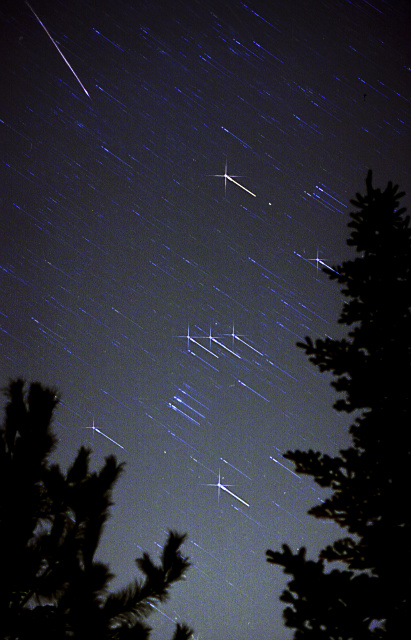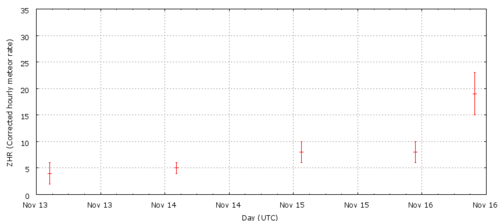사자자리 유성우 정보입니다.
제가 막 고등학교를 졸업할 당시에는 수능 전날이나 다음날에 극대기가 와서, 시험 치르자마자 준비해서 별똥별 보러갔던 기억이 나는군요.
사자자리 유성우는 2001년 당시에 참 많이 떨어졌죠. 당시 극대 주기인 33년쯤에 해당되어서 99년 당시부터 많이 소개되던 유성우입니다. 올해에는 극대기 이전부터 밝은 유성이 보여 기대하고 있었는데, IMO에서 발표를 했죠. "시간 당 150개 정도의 별똥별이 떨어질 것이다."라고.. 우리나라에서는 극대시간에 사자자리가 지평선 아래에 있지만 달도 없고 관측하기 좋은 상황입니다.
아래는 IMO의 발표내용입니다.
Leonids 2009
This year may produce another enhanced return of the Leonid meteor shower, with ZHR hourly rates expected to exceed 150+ according to independent studies by Jérémie Vaubaillon, Mikhail Maslov, Esko Lyytinen, Danielle Moser, David Asher, Mikiya Sato and their respective collaborators (click the links for details). The main peak(s) are expected to occur in the night of November 17 to 18 around 22h00 UT (= 17h00 US Eastern, 23h00 Central Europe, 3h30 India, 6h00 Beijing), although variable activity may happen at almost any stage between November 16 and 18. Continuous monitoring is necessary. Leonids are generally only visible after local midnight from any longitude, with the exception of some long Earth-grazing Leonids before midnight when the radiant is still very low. Consult the shower calendar for more background.
Scientists depend strongly on visual observations by volunteers to test the theoretical models and improve future predictions. For more information on contributing your own observations, please consult the observing instructions and the instructions for filing a report. The IMO offers an electronic report form to submit your observations, and will automatically include them in the ZHR activity graph shown on the right.Important note for visual observers: to allow for detailed analysis, please report the Leonid activity in short intervals. Try to avoid more than 5 to 10 Leonids per interval, and in any case avoid intervals longer than 10-15 minutes throughout November 17. Even when the activity appears poor due to low radiant elevation or bad weather, you may unknowingly be observing an outburst which requires high-resolution data. Note that you can customize the number of rows in the report form (click the link) or simply submit multiple forms.
사실 별똥별은 항상 떨어지지만, 일년에 몇번 특별히 별똥별이 많이 떨어지는 날이 있습니다. 이 때 별똥별의 궤적을 연결하면 한 지점으로 모이는데, 여기에 해당하는 별자리의 이름을 따서 00자리 유성우라고 부르죠.
이번 사자자리 유성우는 사자자리에 그 지점이 위치하는데, 사자자리에서 떨어지는건 아닙니다. 따라서 꼭 사자자리를 바라다 볼 필요는 없습니다. 좀 춥겠지만(방금 나갔다 왔는데 무지 춥더군요.) 돗자리를 깔고 누워서 전체 하늘을 바라다 보면 됩니다.
사진을 찍으실 분들은 10분 정도의 짧은 일주사진을 찍거나 별자리 사진을 찍으면, 운이 좋을 때 별똥별이 지나간 사진도 담을 수 있을겁니다.(이건 순전히 "운"입니다.)
극대 시간은 18일 00시 10분으로 예상되는데, 사자자리가 아직은 지평선 아래에 있죠. 원래 별똥별이 새벽에 밝고 빠른 편이기 때문에 3시경까지는 추위를 참고 기다리시기 바랍니다.
평일이지만 추위를 참고 견디면 분명히 좋은 일이 있을겁니다.
당신의 소원이 이루어지기를 바라며..

2001년 용문산에서 담은 사자자리 유성우
'별보기 > 하늘 소식' 카테고리의 다른 글
| 달과 함께 하는 한해의 마지막, 그리고 한해의 시작 (0) | 2009.12.31 |
|---|---|
| 12월의 밤하늘 (2) | 2009.12.04 |
| 11월의 밤하늘 (0) | 2009.11.11 |
| 제 3회 전국학생천체관측대회 서울-경기-인천지역 예선대회 안내 (0) | 2009.10.09 |
| 10월의 밤하늘 (2) | 2009.09.25 |

